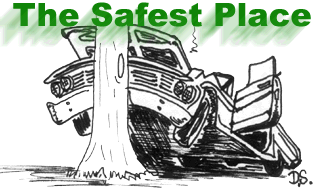 |
 |
Have you ever wandered through a junkyard looking for used auto parts? You'll find some nasty looking carcasses to be sure, but one part of the car's anatomy stays reasonably intact no matter how battered its outsides might be -- the car seats. Anchored to the car's frame and spaced several feet from the dashboard most seats manage to survive crashes. If more passengers were anchored to the frame, like car seats, most people would survive crashes. And if people used their seat belts, they would be anchored to the frame. It's a matter of simple physics. The name of the game its to remain in the safest place, inside the car. In a crash the forces of impact can hurl bodies through the windshield or out the doors or windows. And while it's treacherous enough to smash into a dashboard or windshield, it's murder to be "thrown clear." Thrown clear of what? Oncoming traffic? Telephone poles or trees? Rough, lacerating cement surfaces? Passengers launched from a car in a collision are 25 times more likely to die. What about fires or submersion in a lake or river? Accidents involving fire or submersion make up less than one half of one percent of all traffic accidents. In a collision, if you are not ejected, you will ricochet around the passenger compartment before the car comes to a rest. Now, the only way to escape from a burning or sinking auto, obviously is to remain conscious without any broken bones and without any hemorrhaging gashes. After all, how can you bolt from a burning vehicle if you're lying on the floor with a fractured skull?
REMEMBER...SEAT BELTS KEEP YOU SAFE!
This information was taken from information distributed by The Evergreen Safety Council and posted as a public service to the Car Collectors of America by the Ford Galaxie Club of America